Secondary Amine, Radical, And Alkoxy Amine Compound
WANG; Meng-Wei ; et al.
U.S. patent application number 16/262667 was filed with the patent office on 2020-03-12 for secondary amine, radical, and alkoxy amine compound. This patent application is currently assigned to INDUSTRIAL TECHNOLOGY RESEARCH INSTITUTE. The applicant listed for this patent is INDUSTRIAL TECHNOLOGY RESEARCH INSTITUTE. Invention is credited to Yu-Min HAN, Chih-Hsiang LIN, Meng-Wei WANG.
| Application Number | 20200079889 16/262667 |
| Document ID | / |
| Family ID | 65818156 |
| Filed Date | 2020-03-12 |
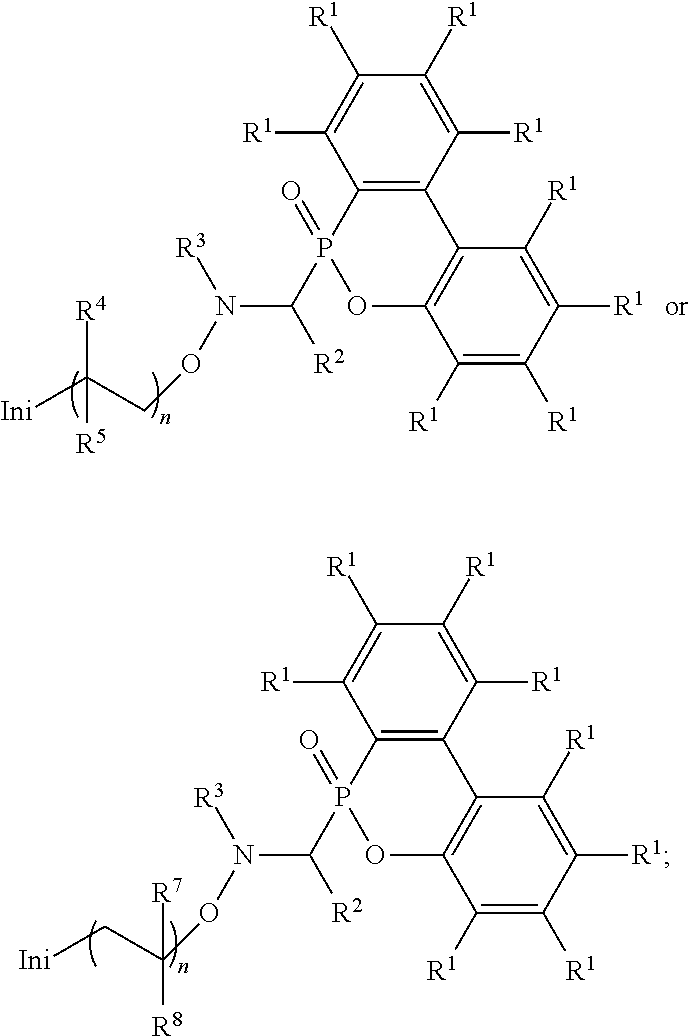
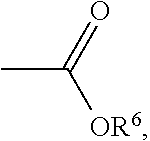



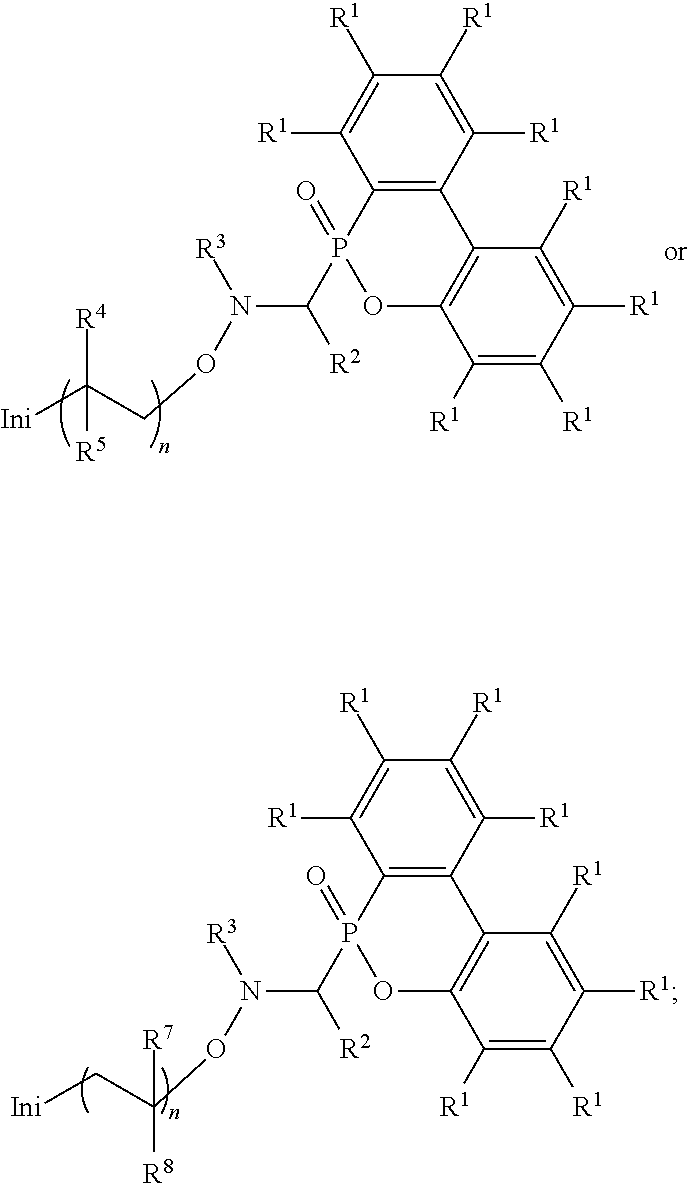
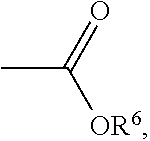
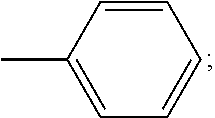

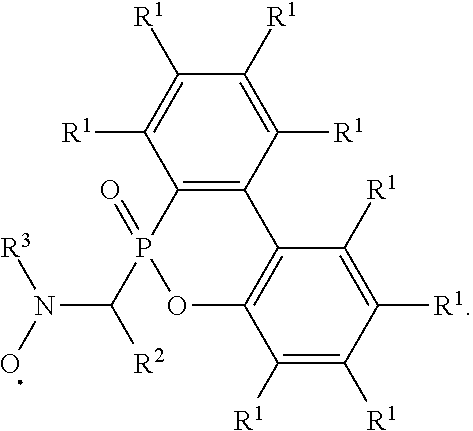


View All Diagrams
| United States Patent Application | 20200079889 |
| Kind Code | A1 |
| WANG; Meng-Wei ; et al. | March 12, 2020 |
SECONDARY AMINE, RADICAL, AND ALKOXY AMINE COMPOUND
Abstract
An alkoxy amine compound is provided, which has a chemical structure of: ##STR00001## wherein each of R.sup.1 is independently H, C.sub.1-6 alkyl group, or C.sub.1-6 alkoxy group; R.sup.2 is C.sub.1-6 alkyl group, R.sup.3 is --(C.sub.xH.sub.2x)--OH or --(C.sub.xH.sub.2x+1), and x is 1 to 8; R.sup.4 is H or C.sub.1-6 alkyl group; R.sup.5 is ##STR00002## and R.sup.6 is H or C.sub.1-8 alkyl group; R.sup.7 is H or C.sub.1-6 alkyl group, R.sup.8 is ##STR00003## Ini is a residual group of a radical initiator; and n is an integer of 1 to 10000.
| Inventors: | WANG; Meng-Wei; (Taichung City, TW) ; HAN; Yu-Min; (Taichung City, TW) ; LIN; Chih-Hsiang; (Taipei City, TW) | ||||||||||
| Applicant: |
|
||||||||||
|---|---|---|---|---|---|---|---|---|---|---|---|
| Assignee: | INDUSTRIAL TECHNOLOGY RESEARCH
INSTITUTE Hsinchu TW |
||||||||||
| Family ID: | 65818156 | ||||||||||
| Appl. No.: | 16/262667 | ||||||||||
| Filed: | January 30, 2019 |
Related U.S. Patent Documents
| Application Number | Filing Date | Patent Number | ||
|---|---|---|---|---|
| 62729658 | Sep 11, 2018 | |||
| Current U.S. Class: | 1/1 |
| Current CPC Class: | C07F 9/65744 20130101; C08F 120/14 20130101; C08F 112/08 20130101; C08F 293/005 20130101; C08F 120/18 20130101; C08F 2/38 20130101; C08F 2438/02 20130101; C07F 9/65522 20130101; C08F 112/08 20130101; C08F 2/38 20130101 |
| International Class: | C08F 293/00 20060101 C08F293/00; C07F 9/6574 20060101 C07F009/6574 |
Foreign Application Data
| Date | Code | Application Number |
|---|---|---|
| Oct 23, 2018 | TW | 107137351 |
Claims
1. A secondary amine, having a chemical structure of: ##STR00031## wherein each of R.sup.1 is independently H, C.sub.1-6 alkyl group, or C.sub.1-6 alkoxy group; R.sup.2 is C.sub.1-6 alkyl group; and R.sup.3 is --(C.sub.xH.sub.2x)--OH or --(C.sub.xH.sub.2x+1), and x is 1 to 8.
2. The secondary amine as claimed in claim 1, wherein R.sup.2 is C.sub.2-4 alkyl group.
3. The secondary amine as claimed in claim 1, wherein x is 2 to 5.
4. A radical, having a chemical structure of: ##STR00032## wherein each of R.sup.1 is independently H, C.sub.1-6 alkyl group, or C.sub.1-6 alkoxy group; R.sup.2 is C.sub.1-6 alkyl group; and R.sup.3 is --(C.sub.xH.sub.2x)--OH or --(C.sub.xH.sub.2x+1), and x is 1 to 8.
5. The radical as claimed in claim 4, wherein R.sup.2 is C.sub.2-4 alkyl group.
6. The radical as claimed in claim 4, wherein x is 2 to 5.
7. An alkoxy amine compound, having a chemical structure of: ##STR00033## wherein each of R.sup.1 is independently H, C.sub.1-6 alkyl group, or C.sub.1-6 alkoxy group; R.sup.2 is C.sub.1-6 alkyl group; R.sup.3 is --(C.sub.xH.sub.2x)--OH or --(C.sub.xH.sub.2x+1), and x is 1 to 8; R.sup.4 is H or C.sub.1-6 alkyl group; R.sup.5 is ##STR00034## and R.sup.6 is H or C.sub.1-8 alkyl group; R.sup.7 is H or C.sub.1-6 alkyl group, R.sup.8 is ##STR00035## Ini is a residual group of a radical initiator; and n is an integer of 1 to 10000.
8. The alkoxy amine compound as claimed in claim 7, wherein R.sup.2 is C.sub.2-4 alkyl group.
9. The alkoxy amine compound as claimed in claim 7, wherein x is 2 to 5.
10. The alkoxy amine compound as claimed in claim 7, wherein the radical initiator comprises azobisisobutyronitrile or benzoyl peroxide.
Description
CROSS REFERENCE TO RELATED APPLICATIONS
[0001] This application claims the benefit of U.S. Provisional Application No. 62/729,658 filed on Sep. 11, 2018, and claims priority from, Taiwan Application Serial Number 107137351, filed on Oct. 23, 2018, the entirety of which are incorporated by reference herein.
TECHNICAL FIELD
[0002] The technical field relates to secondary amine, radical formed from the secondary amine, and alkoxy amine compound formed from the radical.
BACKGROUND
[0003] The major conventional method of forming block copolymers is controlled/living radical polymerization (CRP), which includes nitroxide mediated polymerization (NMP), atom transfer radical polymerization (ATRP), or reversible addition fragmentation chain transfer (RAFT). The requirements for the NMP condition are lower than those for the ATRP condition, meaning that the NMP is more feasible. The NMP initiator is free of sulfur atoms, and the color of the NMP product is lighter than the color of the RAFT product. As such, NMP has inherent advantages for application in optical PMMA. However, nitroxide initiator (the critical technology of NMP) is usually synthesized in several steps. Accordingly, a simplified method of synthesizing a novel nitroxide for NMP is called for.
SUMMARY
[0004] One embodiment of the disclosure provides a secondary amine, having a chemical structure of:
##STR00004##
wherein each of R.sup.1 is independently H, C.sub.1-6 alkyl group, or C.sub.1-6 alkoxy group; R.sup.2 is C.sub.1-6 alkyl group; and R.sup.3 is --(C.sub.xH.sub.2x)--OH or --(C.sub.xH.sub.2x+1), and x is 1 to 8.
[0005] One embodiment of the disclosure provides a radical, having a chemical structure of:
##STR00005##
wherein each of R.sup.1 is independently H, C.sub.1-6 alkyl group, or C.sub.1-6 alkoxy group; R.sup.2 is C.sub.1-6 alkyl group; and R.sup.3 is --(C.sub.xH.sub.2x)--OH or --(C.sub.xH.sub.2x+1), and x is 1 to 8.
[0006] One embodiment of the disclosure provides an alkoxy amine compound, having a chemical structure of:
##STR00006##
wherein each of R.sup.1 is independently H, C.sub.1-6 alkyl group, or C.sub.1-6 alkoxy group; R.sup.2 is C.sub.1-6 alkyl group; R.sup.3 is --(C.sub.xH.sub.2x)--OH or --(C.sub.xH.sub.2x+1), and x is 1 to 8; R.sup.4 is H or C.sub.1-6 alkyl group; R.sup.5 is
##STR00007##
and R.sup.6 is H or C.sub.1-8 alkyl group; R.sup.7 is H or C.sub.1-6 alkyl group, R.sup.8 is
##STR00008##
Ini is a residual group of a radical initiator; and n is an integer of 1 to 10000.
[0007] A detailed description is given in the following embodiments.
DETAILED DESCRIPTION
[0008] In the following detailed description, for purposes of explanation, numerous specific details are set forth in order to provide a thorough understanding of the disclosed embodiments. It will be apparent, however, that one or more embodiments may be practiced without these specific details.
[0009] One embodiment of the disclosure provides a secondary amine and a method of forming the same. For example, a primary amine and an aldehyde can react with each other at room temperature to form an intermediate, which can further react with a derivative of DOPO (9,10-dihydro-9-oxa-10-phosphaphenanthrene 10-oxide) at room temperature to form the secondary amine. The reaction is shown below:
##STR00009##
[0010] In the above reaction, each of R.sup.1 is independently H, C.sub.1-6 alkyl group, or C.sub.1-6 alkoxy group. R.sup.2 is C.sub.1-6 alkyl group. R.sup.3 is --(C.sub.xH.sub.2x)--OH or --(C.sub.xH.sub.2x+1), and x is 1 to 8. In some embodiments, R.sup.2 is C.sub.2-4 alkyl group. In some embodiments, x is 2 to 5. For example, each R.sup.1 is H, R.sup.2 is isopropyl group (e.g. the aldehyde is isobutyraldehyde), and R.sup.3 is hydroxyethyl group (e.g. the primary amine is ethanolamine) or butyl group (e.g. the primary amine is butyl amine). The above reaction may form the secondary amine compound of high purity at room temperature without additional purification (e.g. column chromatography), thereby dramatically lowering the manufacturing cost.
[0011] In one embodiment, the secondary amine can be further oxidized to form a radical, which has a chemical structure of
##STR00010##
In the above chemical structure, each of R.sup.1 is independently H, C.sub.1-6 alkyl group, or C.sub.1-6 alkoxy group; R.sup.2 is C.sub.1-6 alkyl group; and R.sup.3 is --(C.sub.xH.sub.2x)--OH or --(C.sub.xH.sub.2x+1), and x is 1 to 8. In some embodiments, R.sup.2 is C.sub.2-4 alkyl group. In some embodiments, x is 2 to 5. In some embodiments, each R.sup.1 is H, R.sup.2 is isopropyl group, and R.sup.3 is hydroxyethyl group or butyl group. For example, the secondary amine can be oxidized by an oxidant such as hydrogen peroxide, peracetic acid, pertrifluoroacetic acid, nitric acid, oxone, the like, or a combination thereof to form the radical. The radical may stably exist, and can collocate with another radical initiator (e.g. azobisisobutyronitrile (AIBN) or benzoyl peroxide (BPO)) to perform a NMP reaction of monomer having a double bond.
[0012] One embodiment of the disclosure provides an alkoxy amine compound, having a chemical structure of:
##STR00011##
wherein each of R.sup.1 is independently H, C.sub.1-6 alkyl group, or C.sub.1-6 alkoxy group; R.sup.2 is C.sub.1-6 alkyl group; R.sup.3 is --(C.sub.xH.sub.2x)--OH or --(C.sub.xH.sub.2x+1), and x is 1 to 8; R.sup.4 is H or C.sub.1-6 alkyl group; R.sup.5 is
##STR00012##
and R.sup.6 is H or C.sub.1-8 alkyl group; R.sup.7 is H or C.sub.1-6 alkyl group, R.sup.8 is
##STR00013##
Ini is a residual group of a radical initiator; and n is an integer of 1 to 10000. In some embodiments, R.sup.2 is C.sub.2-4 alkyl group. In some embodiments, x is 2 to 5. In some embodiments, each R.sup.1 is H, R.sup.2 is isopropyl group, and R.sup.3 is hydroxyethyl group or butyl group. In some embodiments, the radical initiator may include AIBN or BPO. For example, AIBN, the described radical, and monomer having a double bond can be heated and reacted under nitrogen to form the alkoxy amine compound, and the heating temperature is determined by the monomer having a double bond. For example, when the monomer having a double bond is butyl acrylate, the heating temperature can be about 60.degree. C. When the monomer having a double bond is styrene, the heating temperature can be about 80.degree. C. When the monomer having a double bond is methyl methacrylate, the heating temperature can be about 110.degree. C. R.sup.4, R.sup.5, R.sup.7, and R.sup.8 are determined by the monomer having a double bond. For example, when the monomer having a double bond is butyl acrylate, R.sup.4 will be H, R.sup.5 will be
##STR00014##
and R.sup.6 will be butyl group. When the monomer having a double bond is styrene, R.sup.7 will be H, R.sup.8 will be
##STR00015##
When the monomer having a double bond is methyl methacrylate, R.sup.4 will be methyl group, R.sup.5 will be
##STR00016##
and R.sup.6 will be methyl group. Compared to the conventional NMP mechanism, the heating temperature is lower and the polymerization period is shorter for the radical in the disclosure, and the alkoxy amine compound of the disclosure has a higher number average molecular weight (Mn). For example, the reaction of forming the alkoxy amine compound is shown below:
##STR00017##
[0013] Alternatively, the reaction of forming the alkoxy amine compound can be
##STR00018##
[0014] Ini is a residual group of a radical initiator, which is determined by the radical initiator type. On the other hand, one skilled in the art should understand that the above reaction is only illustrative and not intended to limit the disclosure. One skilled in the art may select suitable reagents and reactions (not limited to the above reagents and reactions) to form the described secondary amine, radical, and alkoxy amine compound. In other words, the secondary amine, radical, and alkoxy amine compound formed from the other reagents and reactions are still included within the scope and spirit of the disclosure.
[0015] Below, exemplary embodiments will be described in detail so as to be easily realized by a person having ordinary knowledge in the art. The inventive concept may be embodied in various forms without being limited to the exemplary embodiments set forth herein. Descriptions of well-known parts are omitted for clarity, and like reference numerals refer to like elements throughout.
EXAMPLES
Preparation Example 1-1
[0016] 11.81 g of isobutyraldehyde (0.1637 mole) was stirred at room temperature. Then, 10 g of ethanolamine (0.1637 mole) was added to the isobutyraldehyde in an ice bath. The ice bath was removed after the addition of ethanolamine, and the reaction was performed at room temperature (25.degree. C.) for 12 hours to form an intermediate. About 50 mL of ethanol solution of DOPO (35.39 g, 0.1637 mole) was added to the intermediate, and then stirred at room temperature for 24 hours to form a white solid, which was naturally precipitated. The white solid was collected by vacuum filtering to obtain a filtered cake, which was a secondary amine product with high purity (yield was about 95%). The hydrogen spectrum of the secondary amine product was as follows: .sup.1H-NMR (400 MHz, DMSO-d.sub.6, .delta., ppm): 10.93 (1H, NH), 8.03, 7.45, 7.26, 7.08, 6.91 (8H, aromatic H), 5.07 (1H, OH), 3.44, 2.76, 2.50, 1.87, 0.82 (12H, aliphatic H). The above reaction is shown below:
##STR00019##
Preparation Example 1-2
[0017] 1 g of the secondary amine product (3.018 mmole) in Preparation Example 1-1 was dissolved in 10 mL of dichloromethane and 3 mL of acetic acid to form a clear solution. 5 mL of hydrogen peroxide (30%) was added to the clear solution, and the mixture was stirred at room temperature and reacted for about 3 hours. The reacted aqueous solution was vigorously stirred, and 5% Na.sub.2CO.sub.3 solution was then added thereto for fine-tuning its pH value to about 5 to 6, thereby precipitating a large amount of white solid. The white solid was collected by vacuum filtering to obtain a filtered cake, which was washed by dichloromethane and then dried under vacuum at 50.degree. C. for 1 hour, which was the radical product (yield was about 90%). The hydrogen spectrum and the mass spectrum of the radical product are as follows: .sup.1H-NMR (400 MHz, DMSO-d.sub.6, .delta., ppm): 8.02, 7.42, 7.23, 7.05, 6.87 (8H, aromatic H), 3.80 (1H, OH), 3.60, 2.56, 2.50, 1.80, 0.60 (12H, aliphatic H). LC-HR/MS (ESI) m/z: [M+2].sup.+ calcd. for C.sub.18H.sub.21NO.sub.4P. 346.3; anal., 465.0855. The above reaction is shown below:
##STR00020##
Preparation Example 2-1
[0018] 11.81 g of isobutyraldehyde (0.1637 mole) was stirred at room temperature. Then, 11.98 g of butylamine (0.1637 mole) was added to isobutyraldehyde in an ice bath. The ice bath was removed after the addition of butylamine, and the reaction was performed at room temperature (25.degree. C.) for 12 hours to form an intermediate. About 50 mL of ethanol solution of DOPO (35.39 g, 0.1637 mole) was added to the intermediate, and then stirred at room temperature for 24 hours to form a white solid, which was naturally precipitated. The white solid was collected by vacuum filtering to obtain a filtered cake, which was a secondary amine product with high purity (yield was about 95%). The hydrogen spectrum of the secondary amine product is as follows: .sup.1H-NMR (400 MHz, CDCl.sub.3, .delta., ppm): 9.94 (1H, NH), 8.11, 7.51, 7.30, 7.22 (8H, aromatic H), 2.72, 2.31, 1.90, 1.25, 0.93, 0.78 (16H, aliphatic H). The above reaction is shown below:
##STR00021##
Preparation Example 2-2
[0019] 1.04 g of the secondary amine product (3.018 mmole) in Preparation Example 2-1 was dissolved in 10 mL of dichloromethane and 3 mL of acetic acid to form a clear solution. 5 mL of hydrogen peroxide (30%) was added to the clear solution, and the mixture was stirred at room temperature and reacted for about 3 hours. The reacted aqueous solution was vigorously stirred, and 5% Na.sub.2CO.sub.3 solution was then added thereto for fine-tuning its pH value to about 5 to 6, thereby precipitating a large amount of white solid. The white solid was collected by vacuum filtering to obtain a filtered cake, which was washed by dichloromethane and then dried under vacuum at 50.degree. C. for 1 hour, which was the radical product (yield was about 90%). The hydrogen spectrum of the radical product is as follows: .sup.1H-NMR (400 MHz, CDCl.sub.3, .delta., ppm): 8.11, 7.51, 7.30, 7.20, 7.03 (8H, aromatic H), 2.78, 2.43, 2.26, 1.32, 1.21, 0.87 (16H, aliphatic H). The above reaction is shown below:
##STR00022##
Example 1
[0020] n-Butylacrylate/the radical product in Preparation Example 1-2/AIBN (molar ratio=100/1/0.1) were added into a reaction bottle. Dimethylacetamide (DMAc) serving as solvent was added to the reaction bottle for preparing solution (50 wt %). The solution was bubbled with nitrogen to deoxygenate for 30 minutes, and then heated to 60.degree. C. and stirred to be reacted for about 2.5 hours. The reaction result was analyzed by GPC to measure its Mn, Mn=161857. The above reaction is shown below:
##STR00023##
Example 2
[0021] n-Butylacrylate/the radical product in Preparation Example 2-2/AIBN (molar ratio=100/1/0.1) were added into a reaction bottle. DMAc serving as solvent was added to the reaction bottle for preparing solution (50 wt %). The solution was bubbled with nitrogen to deoxygenate for 30 minutes, and then heated to 60.degree. C. and stirred to be reacted for about 1 hour. The reaction result was analyzed by GPC to measure its Mn, Mn=107857. The above reaction is shown below:
##STR00024##
Comparative Example 1
[0022] Commercially available NMP reagents TIPNO and TIPNO (commercially available from Sigma-Aldrich) and n-butylacrylate were polymerized for comparison. n-Butylacrylate/TIPNO /TIPNO (molar ratio=100/1/0.1) were added into a reaction bottle. DMAc serving as solvent was added to the reaction bottle for preparing solution (50 wt %). The solution was bubbled with nitrogen to deoxygenate for 30 minutes, and then heated to 75.degree. C. and stirred to be reacted for about 16 hours. The reaction result was analyzed by GPC to prove that no new reaction occurred.
Comparative Example 2
[0023] n-Butylacrylate/TIPNO /TIPNO (molar ratio=100/1/0.1) were added into a reaction bottle. DMAc serving as solvent was added to the reaction bottle for preparing solution (50 wt %). The solution was bubbled with nitrogen to deoxygenate for 30 minutes, and then heated to 125.degree. C. and stirred to be reacted for about 24 hours. The reaction result was analyzed by GPC to measure its Mn, Mn=14981. The above reaction is shown below:
##STR00025##
[0024] As shown in the comparison between Example 1, Example 2, and Comparative Example 2, Mn of the polymers formed at a lower temperature during shorter periods in Examples 1 and 2 were dramatically larger than Mn of the polymer formed at a higher temperature during a longer period in Comparative Example 2.
Example 3
[0025] Styrene/the radical product in Preparation Example 1-2/AIBN (molar ratio=100/1/0.1) were added into a reaction bottle. DMAc serving as solvent was added to the reaction bottle for preparing solution (50 wt %). The solution was bubbled with nitrogen to deoxygenate for 30 minutes, and then heated to 80.degree. C. and stirred to be reacted for about 4 hours. The reaction result was analyzed by GPC to measure its Mn, Mn=18036. The above reaction is shown below:
##STR00026##
Example 4
[0026] Styrene/the radical product in Preparation Example 2-2/AIBN (molar ratio=100/1/0.1) were added into a reaction bottle. DMAc serving as solvent was added to the reaction bottle for preparing solution (50 wt %). The solution was bubbled with nitrogen to deoxygenate for 30 minutes, and then heated to 80.degree. C. and stirred to be reacted for about 2 hours. The reaction result was analyzed by GPC to measure its Mn, Mn=12643. The above reaction is shown below:
##STR00027##
Comparative Example 3
[0027] Styrene/TIPNO /TIPNO (molar ratio=100/1/0.1) were added into a reaction bottle. DMAc serving as solvent was added to the reaction bottle for preparing solution (50 wt %). The solution was bubbled with nitrogen to deoxygenate for 30 minutes, and then heated to 80.degree. C. and stirred to be reacted for about 16 hours. The reaction result was analyzed by GPC to measure its Mn, Mn=910. The above reaction is shown below:
##STR00028##
[0028] As shown in the comparison between Example 3, Example 4, and Comparative Example 3, Mn of the polymers formed during shorter periods in Examples 3 and 4 were dramatically larger than Mn of the polymer formed during a longer period in Comparative Example 3.
Example 5
[0029] Methyl methacrylate/the radical product in Preparation Example 1-2/BPO (molar ratio=100/1/0.1) were added into a reaction bottle. DMAc serving as solvent was added to the reaction bottle for preparing solution (50 wt %). The solution was bubbled with nitrogen to deoxygenate for 30 minutes, and then heated to 110.degree. C. and stirred to be reacted for about 1 hour. The reaction result was analyzed by GPC to measure its Mn, Mn=15823. The above reaction is shown below:
##STR00029##
Comparative Example 4
[0030] Methyl methacrylate/TIPNO /TIPNO (molar ratio=100/1/0.1) were added into a reaction bottle. DMAc serving as solvent was added to the reaction bottle for preparing solution (50 wt %). The solution was bubbled with nitrogen to deoxygenate for 30 minutes, and then heated to 75.degree. C. and stirred to be reacted for about 12 hours. The reaction result was analyzed by GPC to prove that no new reaction was occurred.
Comparative Example 5
[0031] Methyl methacrylate/TIPNO /TIPNO (molar ratio=100/1/0.1) were added into a reaction bottle. DMAc serving as solvent was added to the reaction bottle for preparing solution (50 wt %). The solution was bubbled with nitrogen to deoxygenate for 30 minutes, and then heated to 125.degree. C. and stirred to be reacted for about 24 hours. The reaction result was analyzed by GPC to measure its Mn, Mn=5822. The above reaction is shown below:
##STR00030##
[0032] As shown in the comparison between Example 5 and Comparative Example 5, Mn of the polymer formed at a lower temperature during a shorter period in Example 5 was dramatically larger than Mn of the polymer formed at a higher temperature during a longer period in Comparative Example 5.
[0033] It will be apparent to those skilled in the art that various modifications and variations can be made to the disclosed methods and materials. It is intended that the specification and examples be considered as exemplary only, with the true scope of the disclosure being indicated by the following claims and their equivalents.
* * * * *














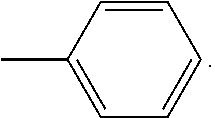
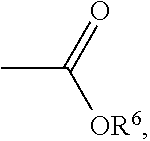
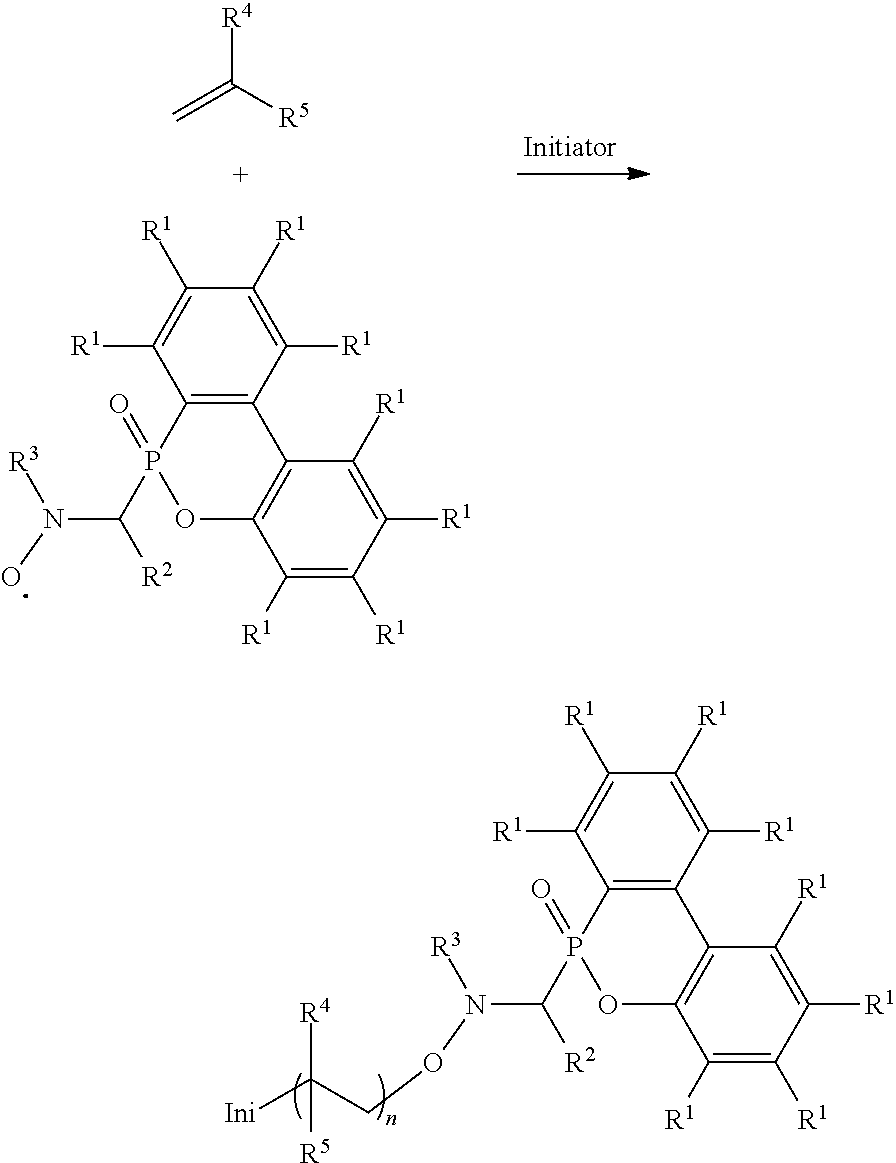
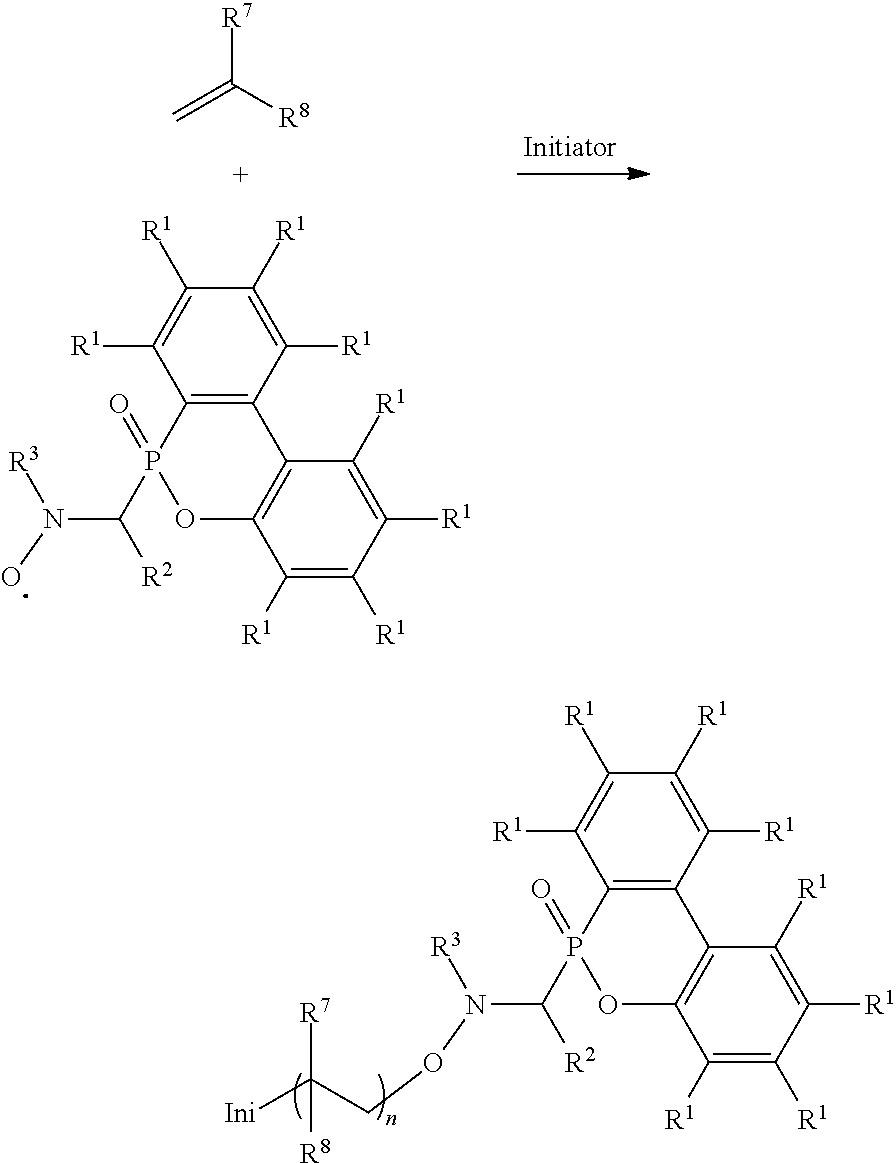
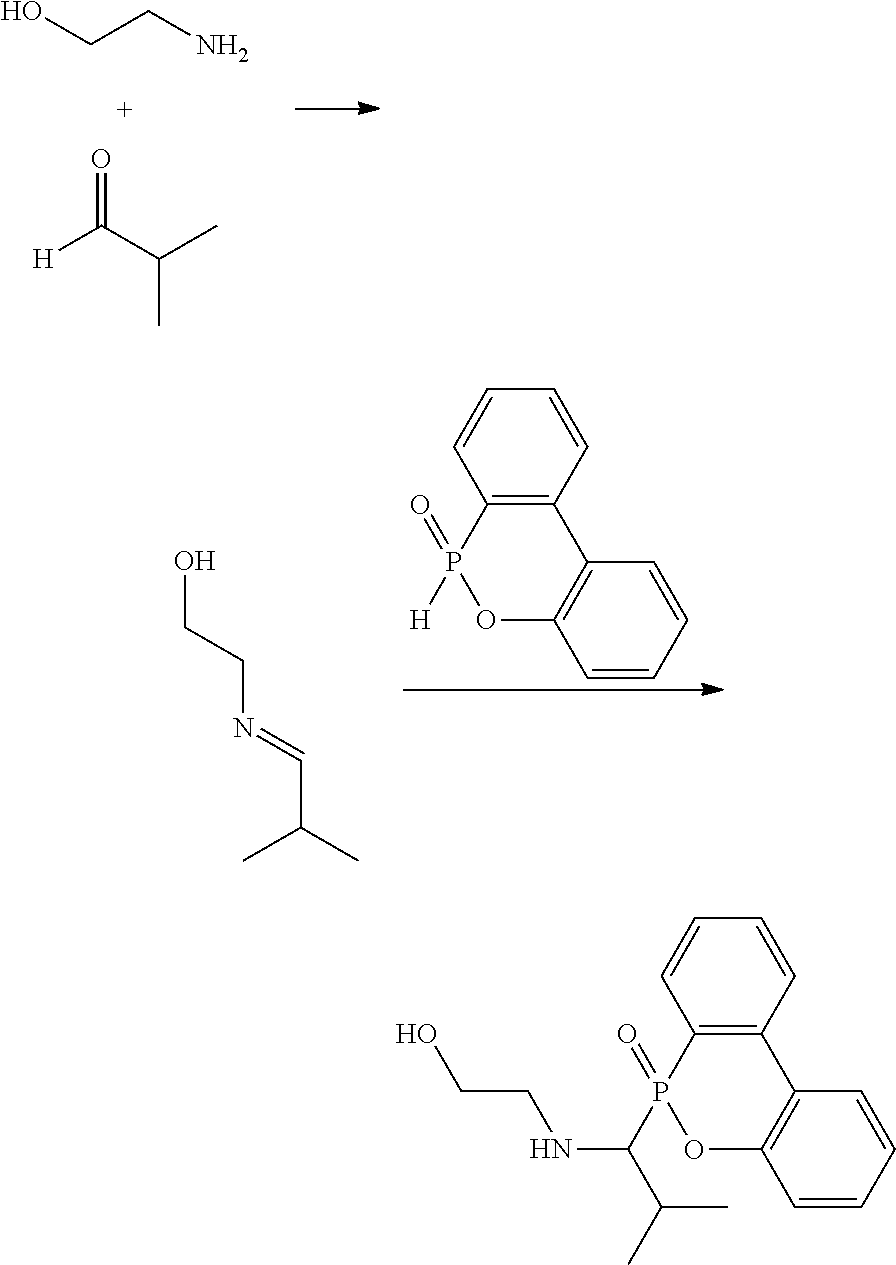
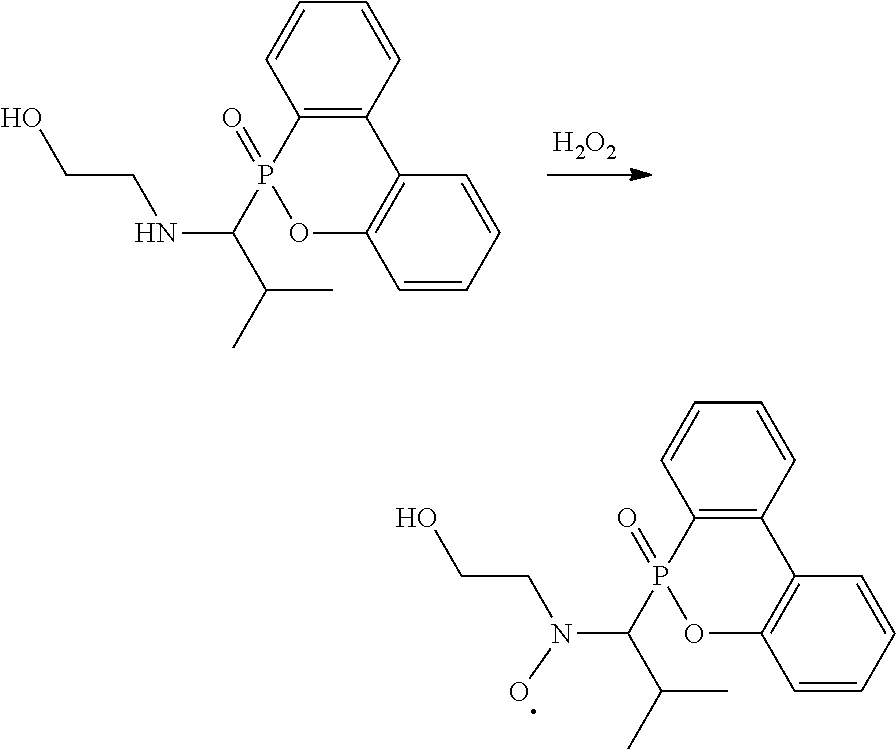
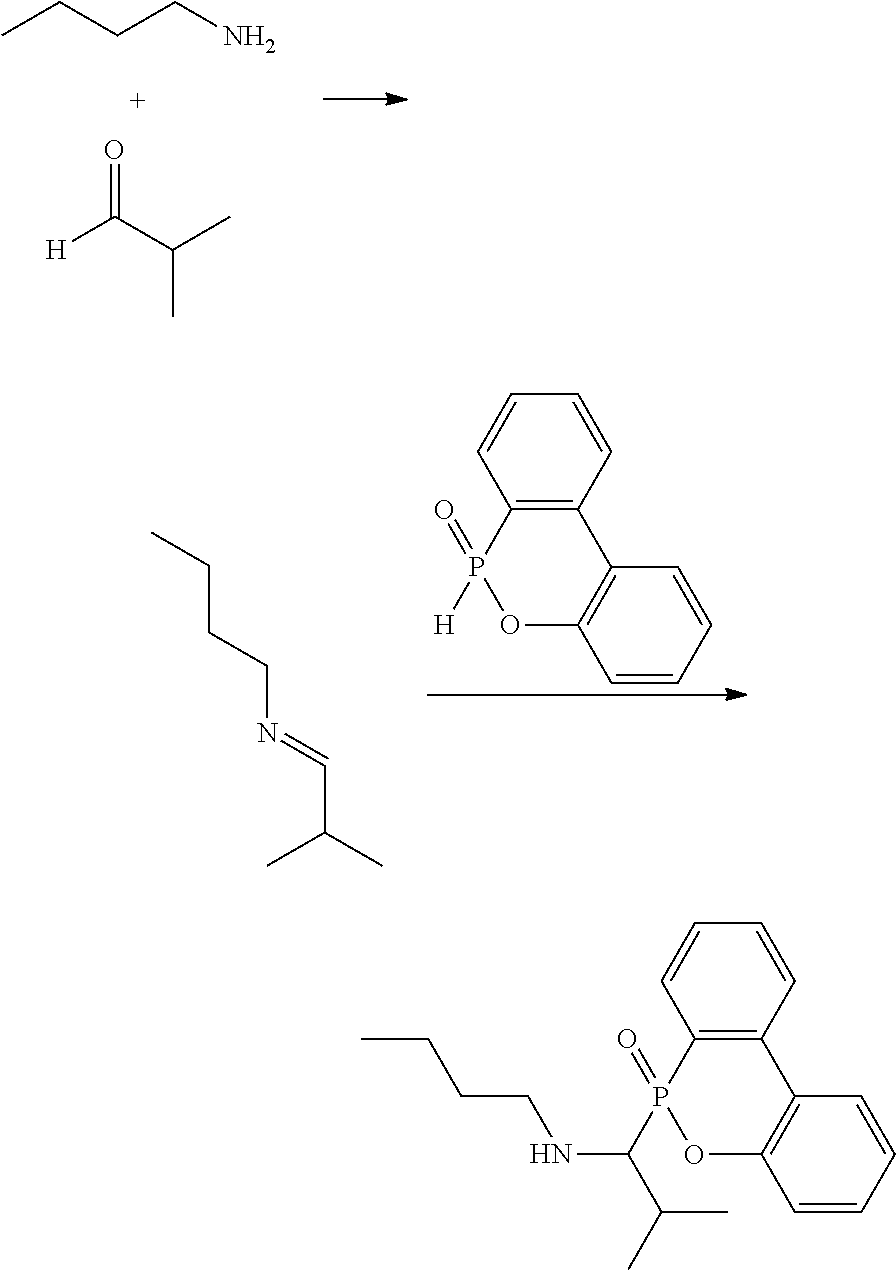
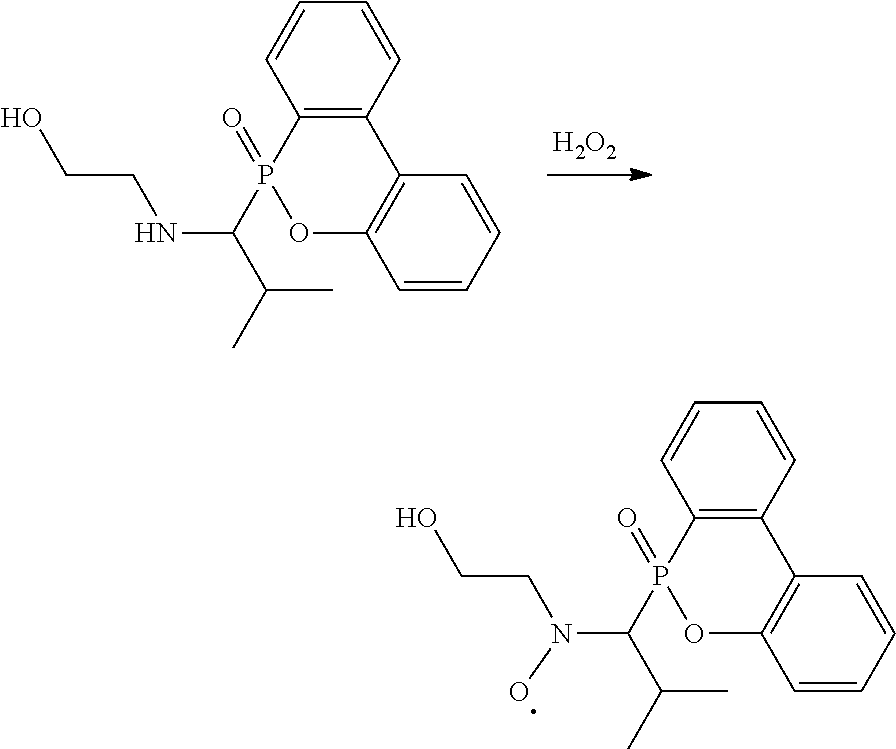
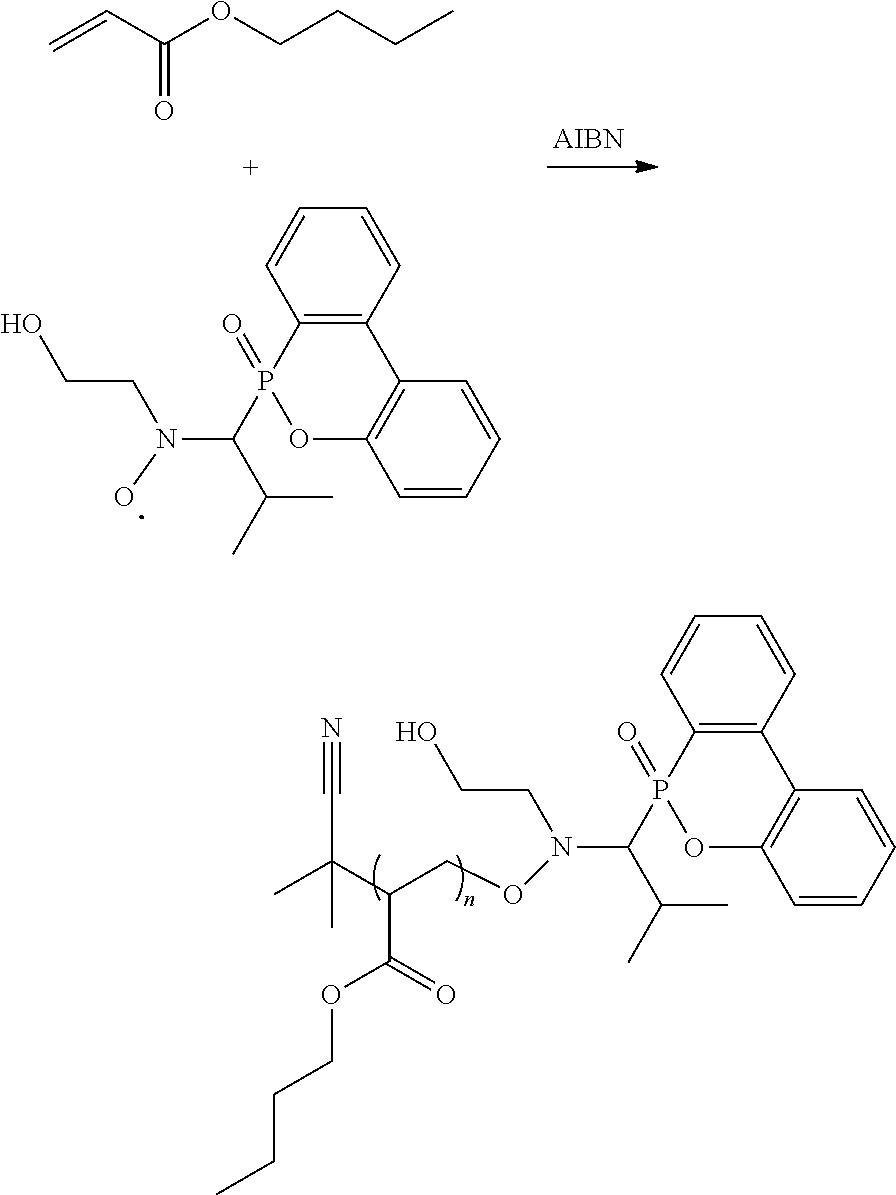



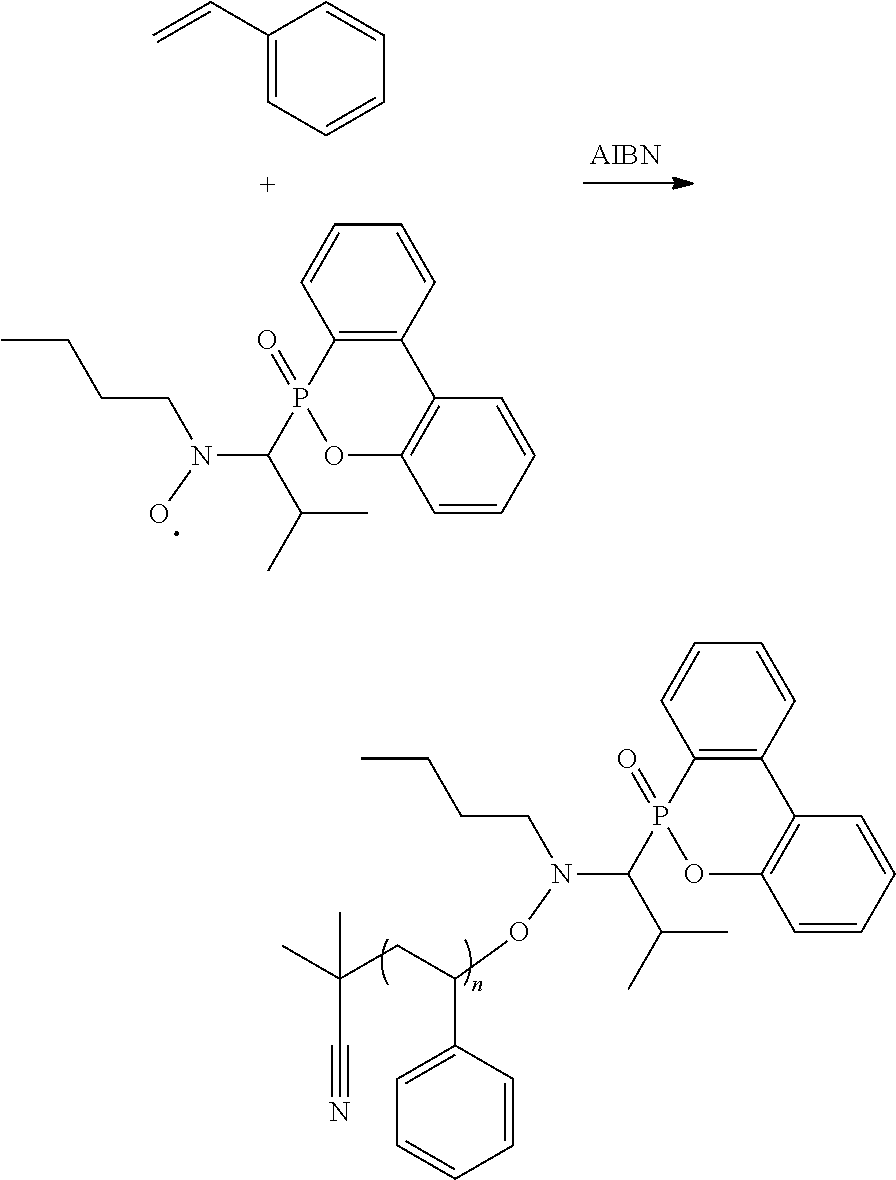
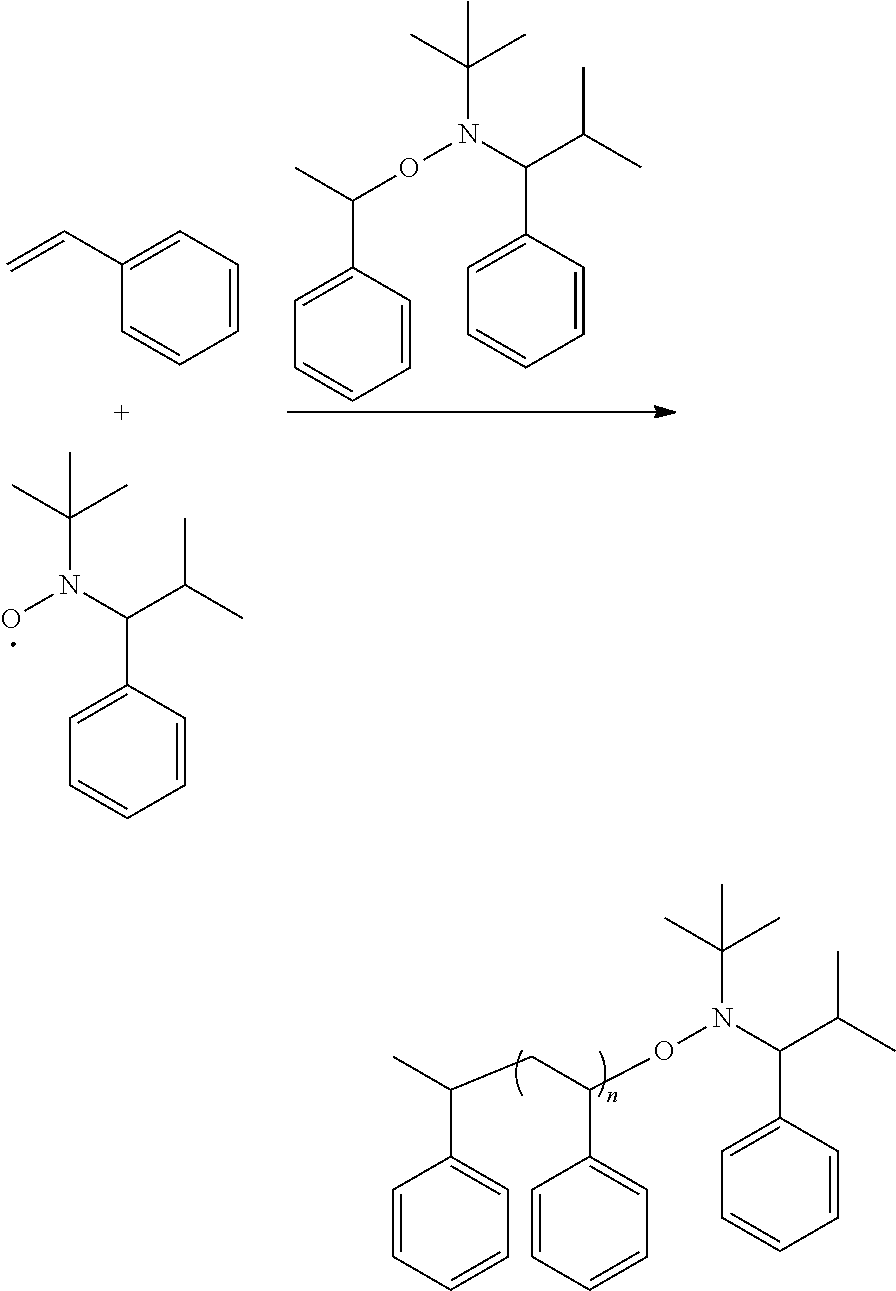
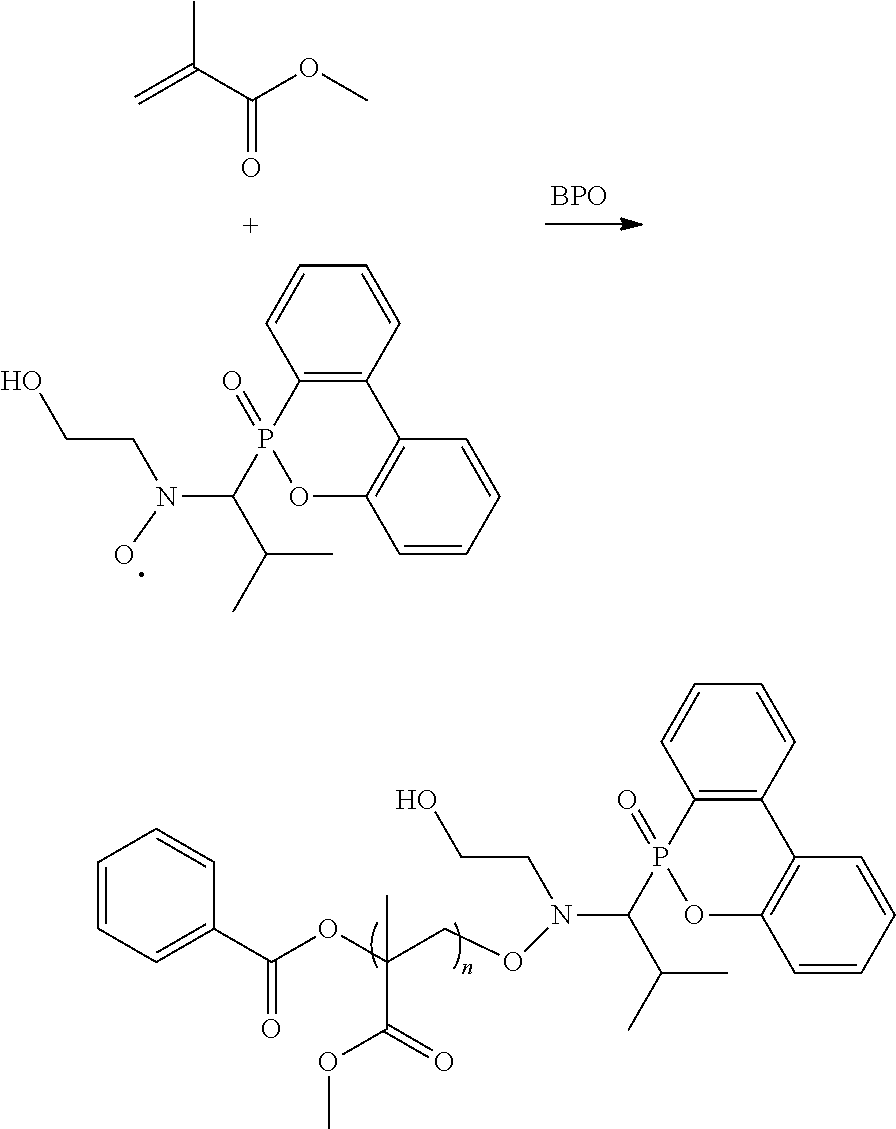
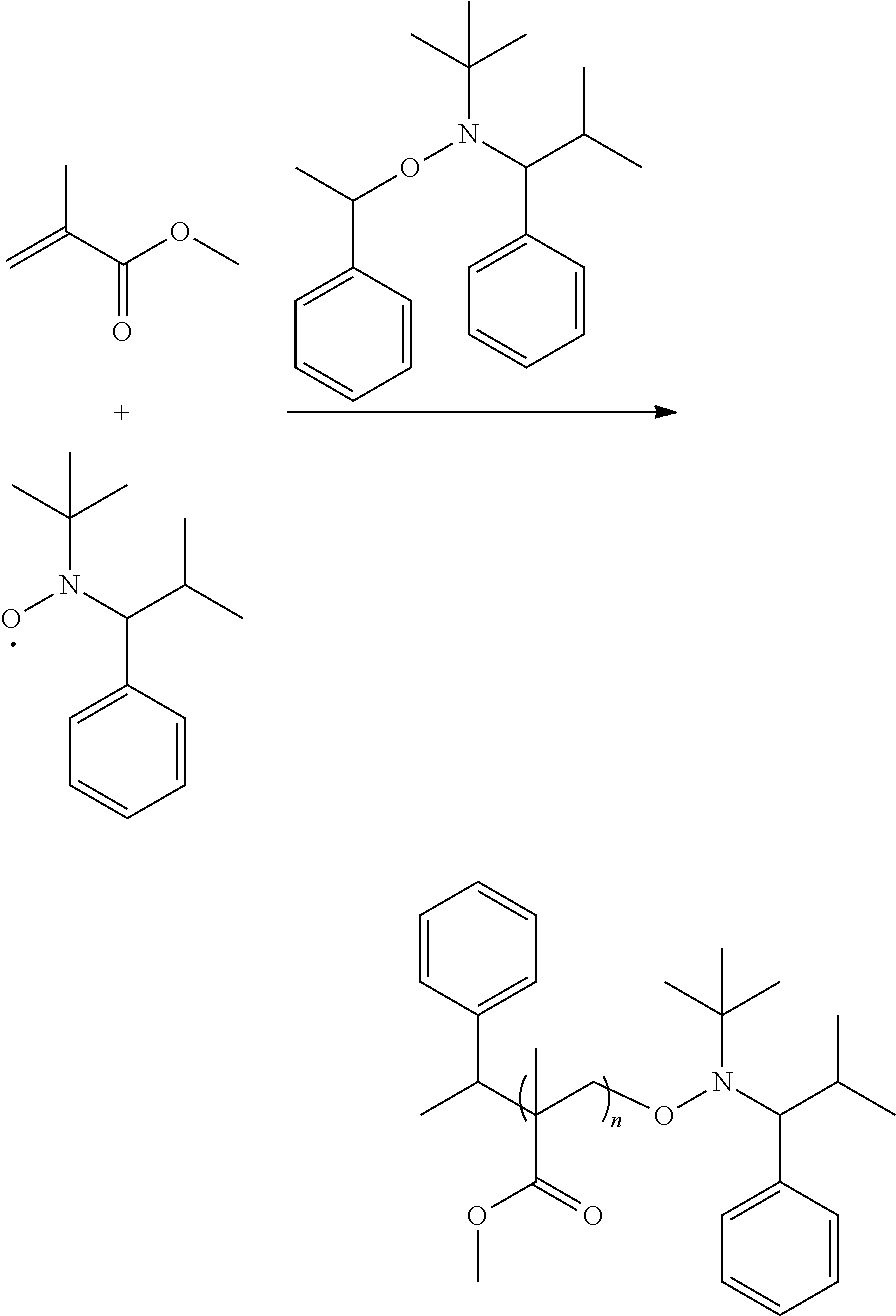
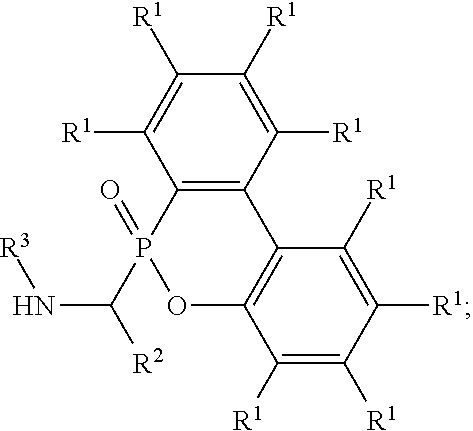
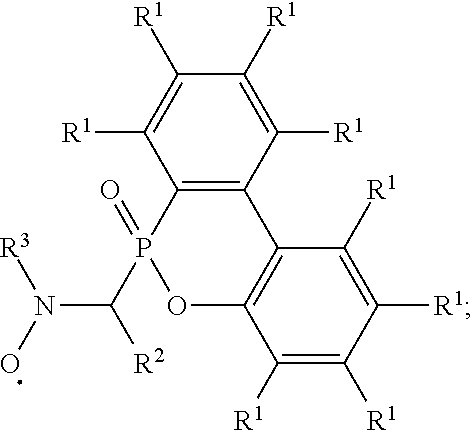

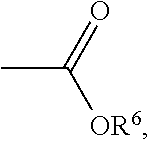

XML
uspto.report is an independent third-party trademark research tool that is not affiliated, endorsed, or sponsored by the United States Patent and Trademark Office (USPTO) or any other governmental organization. The information provided by uspto.report is based on publicly available data at the time of writing and is intended for informational purposes only.
While we strive to provide accurate and up-to-date information, we do not guarantee the accuracy, completeness, reliability, or suitability of the information displayed on this site. The use of this site is at your own risk. Any reliance you place on such information is therefore strictly at your own risk.
All official trademark data, including owner information, should be verified by visiting the official USPTO website at www.uspto.gov. This site is not intended to replace professional legal advice and should not be used as a substitute for consulting with a legal professional who is knowledgeable about trademark law.